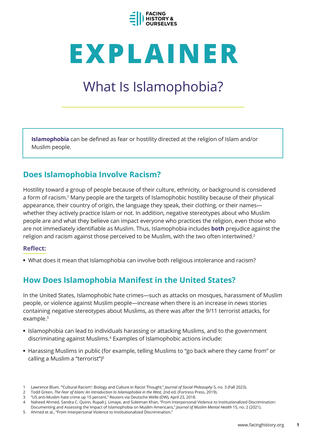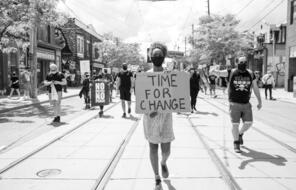What Is Islamophobia?
At a Glance
Language
English — USSubject
- History
- Social Studies
- Racism

What Is Islamophobia? Explainer
Download a PDF of this resource for free
Islamophobia can be defined as fear or hostility directed at the religion of Islam and/or Muslim people.
Does Islamophobia Involve Racism?
Hostility toward a group of people because of their culture, ethnicity, or background is considered a form of racism. 1 Many people are the targets of Islamophobic hostility because of their physical appearance, their country of origin, the language they speak, their clothing, or their names—whether they actively practice Islam or not. In addition, negative stereotypes about who Muslim people are and what they believe can impact everyone who practices the religion, even those who are not immediately identifiable as Muslim. Thus, Islamophobia includes both prejudice against the religion and racism against those perceived to be Muslim, with the two often intertwined. 2
Reflect:
- What does it mean that Islamophobia can involve both religious intolerance and racism?
How Does Islamophobia Manifest in the United States?
In the United States, Islamophobic hate crimes—such as attacks on mosques, harassment of Muslim people, or violence against Muslim people—increase when there is an increase in news stories containing negative stereotypes about Muslims, as there was after the 9/11 terrorist attacks, for example. 3
Islamophobia can lead to individuals harassing or attacking Muslims, and to the government discriminating against Muslims. 4 Examples of Islamophobic actions include:
- Harassing Muslims in public (for example, telling Muslims to “go back where they came from” or calling a Muslim a “terrorist”) 5
- Committing violent hate crimes against Muslims 6
- Harassing or attacking Muslim women wearing religious coverings, such as a headscarf known as a hijab 7
- Vandalizing or firebombing Muslim buildings, such as community centers or mosques 8
- Targeting Muslims for security screening while traveling or for government surveillance 9
- Restricting the ability of Muslims to move to the United States or become US citizens through targeted policies 10
Reflect:
- Which of the Islamophobic actions above likely involve individual perpetrators? Which likely involve government actions?
- How might the Islamophobic actions listed above impact the people who are targeted?
What Are Common Islamophobic Tropes?
A trope is a widely shared idea, stereotype, phrase, image, or story. Tropes can be neutral, like common movie or literary tropes, but Islamophobic tropes cause great harm.
Islamophobic Trope 1: All Muslims Are the Same
According to this trope, all Muslims hold the same views and practice their religion in the same way. When all members of a group are assumed to be the same, stereotypes can take root and spread, including negative stereotypes. For example, someone who holds the belief that all Muslims are the same might see a news story about an individual Muslim who acted violently and falsely assume that all Muslims are violent. This same person might see a news story about a Christian acting violently and not make a similar assumption that all Christians are violent. This trope is at the core of Islamophobia, and it can amplify any negative stereotypes about Islam or about Muslim people.
In reality, Muslims constitute a large and incredibly diverse group of people. In 2012, there were an estimated 1.6 billion Muslims around the world. 11 A Pew Research survey, which involved interviews with 38,000 Muslims in over 80 languages, found that while most Muslims share a set of core beliefs, they also hold a wide range of views about how to practice their religion. 12
In the United States, there are an estimated 3.45 million Muslims, which is approximately 1% of the total population. 13 According to scholar Kambiz GhaneaBassiri, “Not only have Muslims of varying ethnic and sectarian orientations from every corner of the world immigrated to the United States, but Americans of African, European, Latin, and Native American ancestries have converted to Islam as well.” 14 GhaneaBassiri goes on to write that “there is no single American Muslim experience.” 15
Islamophobic Trope 2: Islam Is Incompatible with the West 16
According to this trope, Islam is inherently foreign to Western countries, including the United States, and the culture associated with Islam is in opposition to Western culture. This trope also leads people to view Muslims as perpetual outsiders, even when the United States or another Western country is their home.
In reality, there have been exchanges of culture and knowledge between people in the West and people in majority-Muslim regions since the very beginning of Islam, and Muslims made substantial contributions to the European Renaissance. While Muslims have been a minority in the United States throughout the country’s history, they have actively influenced American society and culture from the beginning. 17 Muslim navigators likely arrived in what is now the United States along with the earliest European explorers, and it is likely that there were Muslims among early European settlers. 18 Muslims also constituted a substantial portion of the people who were enslaved and forcibly brought from Africa to North America. 19 Today, Muslims continue to interact with and contribute to American society in a range of ways, as do other populations in the United States.
Islamophobic Trope 3: Islam Is Inherently Oppressive to Women
According to this trope, all Muslim women are oppressed or required to be submissive to men. The fact that there are Muslim-majority countries that deny women equal legal rights is considered evidence for this trope, as is the fact that some Muslim women wear the hijab (a scarf that covers the hair) or other religious head or face coverings.
While some interpretations of Islam—such as those guiding the rulers of Iran, Afghanistan, and Saudi Arabia—deny women equal rights, women’s status and rights vary widely throughout Muslim communities, as they do in other communities. For example, women have unequal status in some countries that are not majority Muslim. Around the world, women are underrepresented in top government positions, and two-thirds of countries have never had a female head of state. The fact that nine Muslim-majority countries, including Pakistan, Bangladesh, and Senegal, have had female heads of state challenges this trope.
Practices related to women’s religious covering also vary widely throughout Muslim communities. In a few Muslim-majority countries such as those named above, women are required to wear coverings. However, in most majority-Muslim countries and throughout all Western countries, religious coverings, such as the hijab, are not mandated for women, and Muslim women have the legal right to choose whether or not to wear some form of covering as part of their religious expression. When Muslim women in Western countries choose to wear a form of religious covering, they are often harassed, which restricts their freedom of choice. Religious coverings are not unique to Islam, and some women who practice other religions, such as Christianity and Judaism, also wear head coverings.
Islamophobic Trope 4: Islam Is Violent and Muslims Are the Enemy
According to this trope, Islam is an inherently violent religion, and all Muslims are potential terrorists. This trope justifies viewing Muslims with suspicion, especially Muslim men, and assuming that they are violent and dangerous.
In reality, the vast majority of Muslims condemn violent extremism. 20 Throughout history, people have used their own interpretations of their religion—including Christianity, Islam, and other religions—to justify committing violence. The fact that this happens does not mean that these religions are inherently violent. When the perpetrator of a violent extremist act is white, media coverage is more likely to portray the crime as an isolated event, not one that is motivated by group membership or ideology, while when a perpetrator is Muslim or non-white, the crime is more likely to be characterized as an act of terrorism. 21 Evidence collected by the US government shows that white supremacist extremists, not Muslim extremists, pose the greatest domestic terrorism threat in the United States. 22 These different depictions of violent extremism can fuel the false assumption that Muslims are particularly violent, which in turn is used to justify increased surveillance of Muslims and the restriction of Muslims’ rights.
Reflect:
- How do these tropes reinforce Islamophobia?
- How might the first trope (that all Muslims are the same) amplify the other tropes?
What Impact Does Islamophobia Have on Individuals?
Muslims experience Islamophobia in a variety of ways, and common reactions include:
- Deciding to conceal their Muslim identity (for example, by changing their name or way of dressing)
- Becoming more aware of or vocal about their identity as a Muslim
- Withdrawing from society
- Maintaining vigilance in public spaces against attacks
- Becoming more politically engaged (for example, by raising awareness about Islamophobia or joining a political campaign)
23
Each of the following quotes describes a different Muslim person’s experience of Islamophobia.
Quote 1, from a Muslim woman on her choice to wear, or not wear, a hijab:
“I did wear hijab for 14 years, and I took it off, now almost three years ago, because I could just see in my own life the way that the situation is getting worse and worse, and I could just feel the hostility when I did wear hijab. I mean, even now, it’s fascinating to see how people treat me before they find out I’m Muslim, and then afterward. It’s just—as soon as you say that word, Muslim, you can literally see all of this, like, implicit bias rising up in people, and even just their physical reaction to me changing. When I did wear hijab, the situation was much more obvious. I mean, I had people scream at me on the street, call me a terrorist. Tell me to go back to my own country, which is totally bizarre, because I was born and raised here [in the United States]. I’m also a convert. So seeing all that [was] very upsetting, but also eye opening about the real state of racism. Just the way that you can be walking down the street, and people will whisper horrible things to you, so that nobody else around them can hear it, leaving me just kind of standing there like, ‘Did I just imagine that this person called me a terrorist?’” 24
Quote 2, from a Muslim woman on her experiences in school after 9/11:
“After 9/11, I think that there are a lot of us that had certain stories about [people asking]: Is Osama your uncle? Or are you a terrorist? That happened. . . . references to how we’re just like violent and belligerent by nature. Those were things that occurred right after 9/11, in my classroom and with teachers present. So there is this condoning of behaviors that I think adults shouldn’t be condoning.”
Quote 3, from a Muslim man on experiencing profiling while traveling:
“I’ve continually been stopped and had trouble at airports and borders. Like, I have been stopped at the [country name] border for five or six hours for no real reason, presumably because I’m Muslim or have a Muslim name or whatever. And I asked them—in certain cases, although not all of them, when I ask why I’ve been stopped, they’ll say it’s because you share a name with a bad guy.”
Quote 4, from a Muslim man on feeling excluded and unsafe:
“It just makes you feel very unwelcome. You know, not sure—can you be safe, is what I guess a lot of people would say. Is your personal safety guaranteed in this situation? But I would say, for me, I kind of don’t worry much at all about my safety, perhaps as much as I should, but this feeling of being unwelcomed, and just not being sure if my neighbors want to talk to [me]: Should I just stay isolated in my house?”
Quote 5, from a Muslim man on experiencing profiling while traveling and feeling excluded:
“You worked so hard to claim your American identity. And you realize how quickly it can be taken from you. I mean, I’ve had incidents at airports . . . and you realize how marginalized you can become. How, even though we have certain rights, it feels like they’re very fragile. And then it’s hard to feel truly American when other Americans don’t want to accept your Americanness.”
Reflect:
- What tropes are at play in the Islamophobic incidents these accounts describe?
- What impact do these individuals describe Islamophobic incidents as having had on them?
- 1Lawrence Blum, “‘Cultural Racism’: Biology and Culture in Racist Thought,” Journal of Social Philosophy 5, no. 3 (Fall 2023).
- 2Todd Green, The Fear of Islam: An Introduction to Islamophobia in the West, 2nd ed. (Fortress Press, 2019).
- 3“US anti-Muslim hate crime up 15 percent,” Reuters via Deutsche Welle (DW), April 23, 2018.
- 4Naheed Ahmed, Sandra C. Quinn, Rupali J. Limaye, and Suleiman Khan, “From Interpersonal Violence to Institutionalized Discrimination: Documenting and Assessing the Impact of Islamophobia on Muslim Americans,” Journal of Muslim Mental Health 15, no. 2 (2021).
- 5Ahmed et al., “From Interpersonal Violence to Institutionalized Discrimination.”
- 6“US anti-Muslim hate crime up 15 percent,” Reuters/DW.
- 7Ahmed et al., “From Interpersonal Violence to Institutionalized Discrimination.”
- 8“Nationwide Anti-Mosque Activity,” ACLU, December 2023.
- 9Sabrina Alimahomed-Wilson, “When the FBI Knocks: Racialized State Surveillance of Muslims,” Critical Sociology 45, no. 6 (2019): 871–87.
- 10“US anti-Muslim hate crime up 15 percent,” Reuters/DW.
- 11“The World’s Muslims: Unity and Diversity,” Pew Research Center, August 9, 2012.
- 12 “The World’s Muslims,” Pew Research Center.
- 13 “US Muslims Concerned about Their Place in Society, But Continue to Believe in the American Dream ,” Pew Research Center, July 26, 2017.
- 14 Kambiz GhaneaBassiri, A History of Islam in America (Cambridge University Press, 2012), Kindle edition, 2.
- 15 GhaneaBassiri, A History of Islam in America.
- 16 “The West” refers to countries that have cultural and ethnic origins in Western Europe; that share economic, social, and political views and interests; and that, due to their colonial histories, have significant economic and political power. This includes the United States, Canada, Australia, and New Zealand, along with European countries. While there are many problems with this term, notably its colonial roots and how it places “the West” in contrast to “the East,” it does still have widespread traction and use. Moreover, it highlights the shared culture and mindset of countries that cannot be grouped together under a geographical term or location.
- 17 George Saliba, Islamic Science and the Making of the European Renaissance (MIT Press, 2017).
- 18 GhaneaBassiri, A History of Islam in America.
- 19 GhaneaBassiri, A History of Islam in America.
- 20 Anthony H. Cordesman, “Islam and the Patterns in Terrorism and Violent Extremism ,” Center for Strategic & International Studies (CSIS), October 17, 2017.
- 21 Kathleen Belew, Bring the War Home: The White Power Movement and Paramilitary America (Harvard University Press, 2019).
- 22 “ Peters Investigative Report Shows DHS and FBI Are Not Adequately Addressing Domestic Terrorism Threat ,” US Senate Committee on Homeland Security & Governmental Affairs, November 16, 2022.
- 23 Ahmed et al., “From Interpersonal Violence to Institutionalized Discrimination.”
- 24Ahmed et al., “From Interpersonal Violence to Institutionalized Discrimination.”













